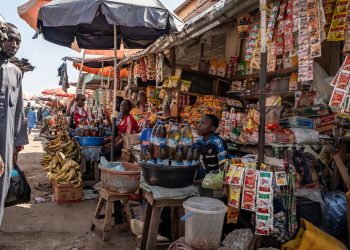Bank lending is a major source of funding for businesses in Ghana. It helps pay for operational expenditure and investment in expansion of productive capacity. Therefore, it is important that there is substantial, affordable, and accessible financial credit for all businesses in the medium to long term. More than this, it matters which sectors of the country’s economy receive most of its bank credit.
In a recent study of the sectoral distribution of bank lending in Ghana, I found that for two and a half decades, bank lending to the agricultural and manufacturing enterprises has been in sharp decline.
In the 25 years from 1999 to 2023, the share of total bank credit that went to the agricultural and manufacturing sector fell by about 65% and 56% respectively. For instance, in 1999, about 25% of total bank lending went to manufacturing businesses. By 2023 however, that figure had fallen to about 11%.
I am an economist with expertise in the political economy of money, finance, and development in Africa. My research on Ghana has attempted to explain the financial constraints to the country’s economic transformation since independence in 1957. I have previously written on Ghana’s sovereign indebtedness and its banking and monetary policies.
The findings in the current study matter because in Ghana, agriculture and manufacturing are crucial to creating substantial, sustainable, and shared economic growth. Agriculture is the second largest employer in Ghana’s economy after the services sector. It is also crucial for creating the raw materials that can fuel manufacturing sector growth.
The role of banks & finance in economic development
There is no single perspective among economists on how banks operate or should operate in an economy. There are those economists within neoclassical economics circles who hold the conventional, largely discredited view that banks act merely as intermediaries who take money from savers and lend to borrowers.
In contrast, there are those, particularly post-Keynesian economists, who assert, rightly, that modern banks do not merely receive deposits and turn them into loans. They insist that banks create credit for borrowers but not necessarily from savers’ deposits.
Still, most economists agree on some things. First of all, that finance is crucial to economic development. Secondly, that the banking system has a role in the flow of finance to individuals, households and businesses.
Not all forms of financial flows are healthy for economic transformation, however. The key then for successful financial policy is to distinguish between productive and unproductive credit.
Productive credit flows support the entrepreneurial innovation that is central to creating new products or expanding production levels. This kind of credit will for instance support agricultural production and expand manufacturing capacity and outputs.
Unproductive credit does not increase the level of output. For instance, lending to support household consumption or financial speculation is unproductive.
The Ghanaian banking system does not generate enough credit for the private sector. However, that was hardly the concern for this study. Of particular interest is the question: where does the credit go to?
Bank credit to agriculture and manufacturing has declined
My study set out to disaggregate the data on financial credit to the various sectors of the Ghanaian economy. These sectors included agriculture, manufacturing and services. The evidence shows that bank lending has not significantly supported real productive sectors such as agriculture and manufacturing.
As indicated in Figures 1 and 2, the shares of financial credit to the agricultural and manufacturing have been in decline. On average, over the last 25 years, 14.6% and 5.8% of total bank credit was allocated to manufacturing and agriculture respectively. In contrast, the services sector averaged 20.7% of bank credit. Commerce and finance sector received an average of 17.3% over the same period.
As productive sectors are denied sufficient credit, well-paid and sustainable jobs cannot be created in agriculture or manufacturing as most Ghanaians are reduced to informal petty trading of foreign goods.
Two main reasons have accounted for this dysfunction of the financial system. First, the foreign domination of Ghana’s banking sector, and second the failure of monetary policy. About 50% of banks in Ghana are foreign owned. Foreign banks tend to be more risk averse. They are less likely to lend to small and medium-scale enterprises (SMEs).
Second, the Bank of Ghana’s excessive focus on monetary stability through inflation-targeting is problematic. It often results in raising interest rates and, consequently, borrowing costs. This discourages private sector borrowing while attracting bank investments into government securities. Ghana’s inflation is largely driven by structural factors and not money supply problems. These factors include production and transport costs. Monetary stability through inflation-targeting is therefore a misplaced priority.
Besides, by focusing solely on monetary stability, the central bank is neglecting its role to support the overall development of the economy through credit policy. This developmental role is clearly set out in The Bank of Ghana (Amendment) Act 2016 (Act 918). This revised the 2002 Act to take account of the central bank’s role to support government economic policy and ensure an efficient operation of the banking and credit system.
Before the IMF-led financial reforms of the 1980s and 1990s which were necessitated by the 1980s financial crisis, the Bank of Ghana intervened, effectively and efficiently, to direct credit to priority sectors. For instance, in the early 1980s when the liberal financial reforms had not taken root in Ghana, the Bank of Ghana used a combination of credit ceilings, interest rates, reserve requirements, and mandatory lending ratios to direct credit to agriculture and industry. Credit ceilings ensured that banks could not lend beyond a certain limit to sectors other than agriculture and manufacturing. Lower interest rates were also offered to agricultural loans and in other instances, mandatory lending ratios ensured banks were forced to lend a certain share of loans to agriculture and manufacturing.
Drawing lessons from the present moment and past, I recommend a serious rethink of financial policy. A return to some level of credit policies, a deliberate support for indigenous participation in the banking system and a revitalisation of development banks such as the Agricultural Development Bank and the National Investment Bank.
This article is the outcome of research conducted within the Africa Multiple Cluster of Excellence at the University of Bayreuth, funded by the Deutsche Forschungsgemeinschaft (DFG, German Research Foundation) under Germany's Excellence Strategy – EXC 2052/1 – 390713894
















